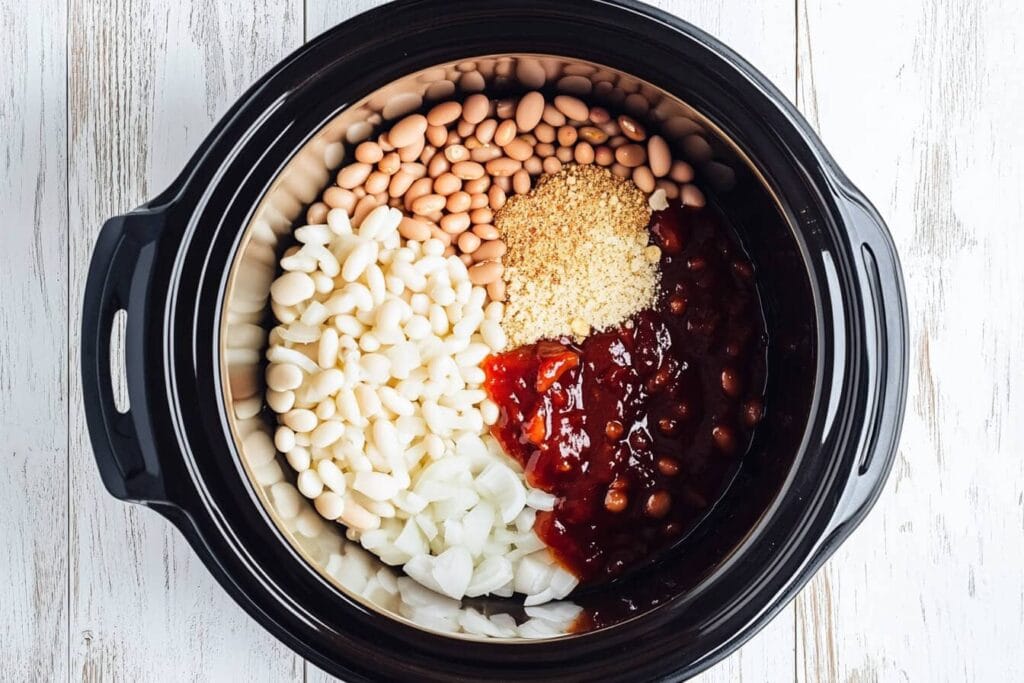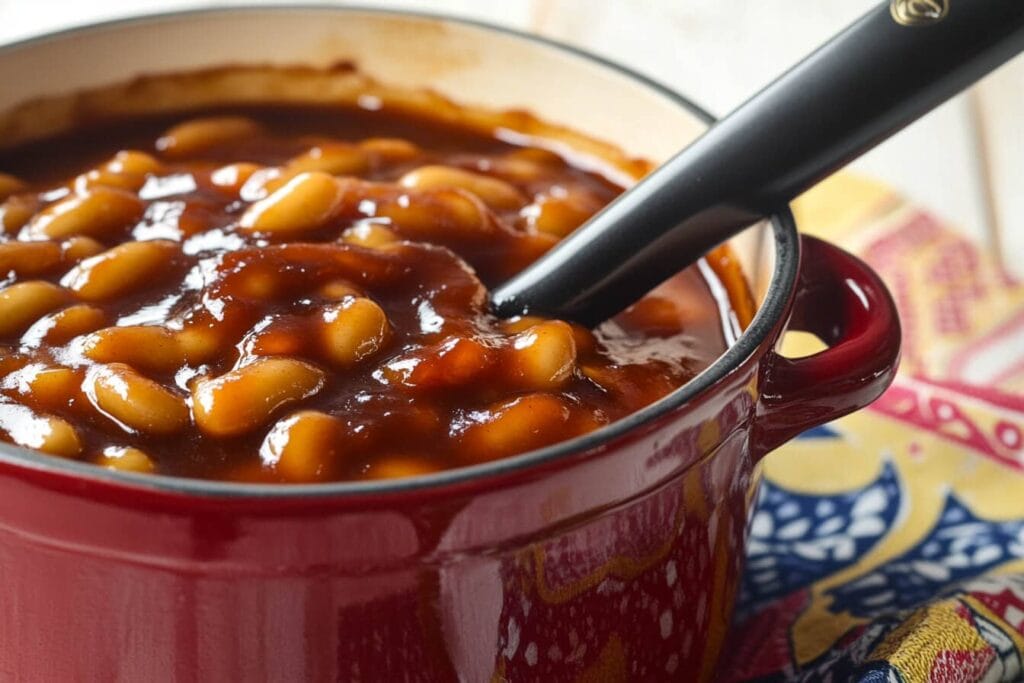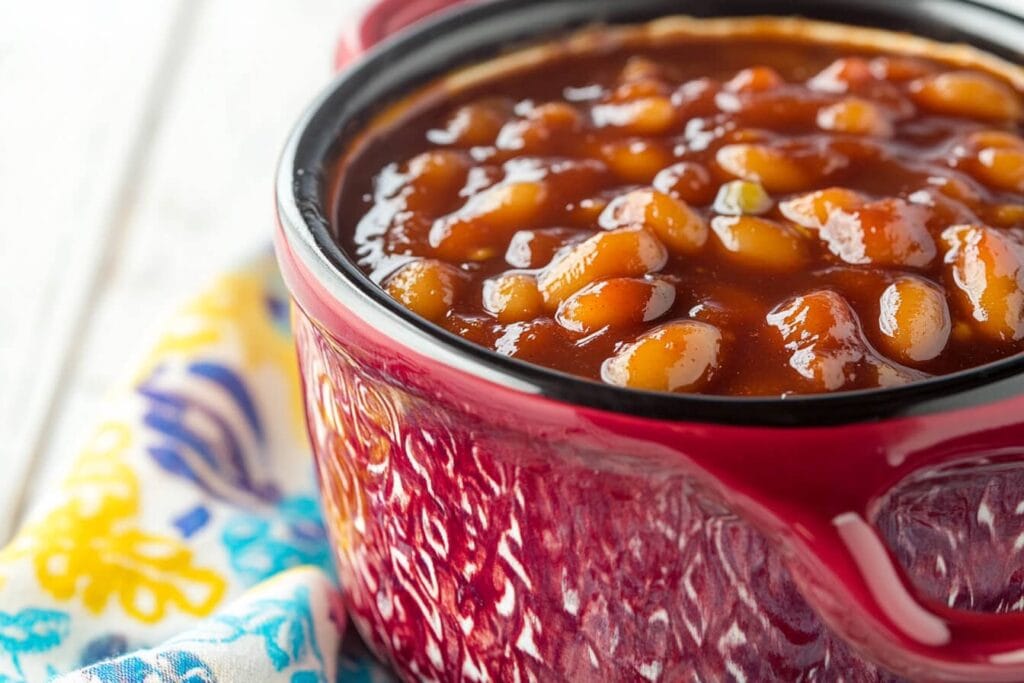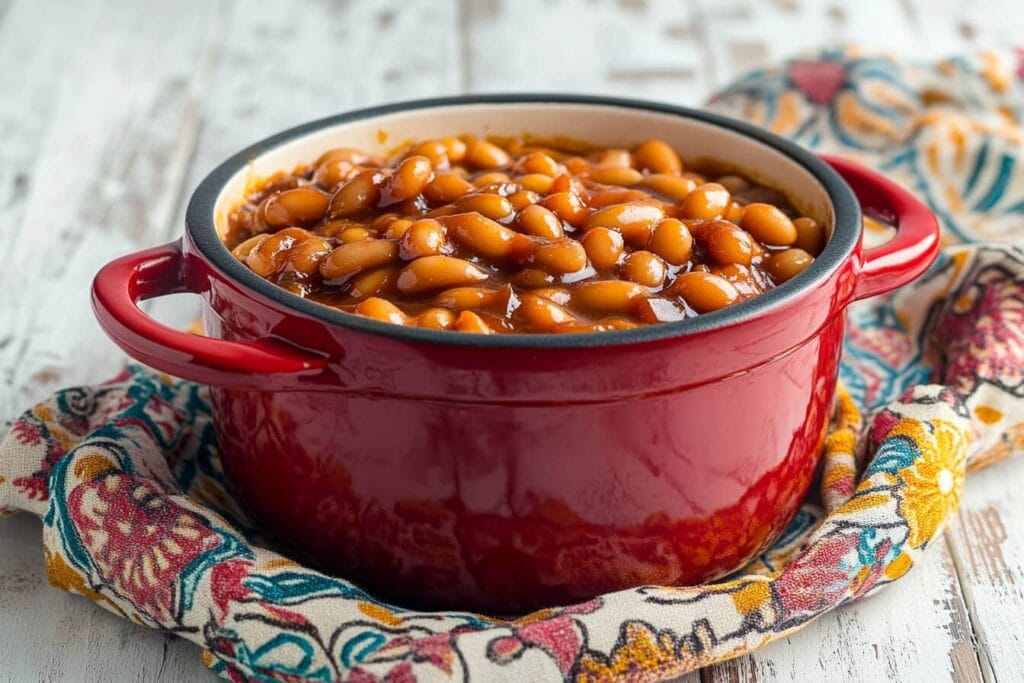This baked beans recipe is the ultimate side dish for summer potlucks, backyard BBQs, and even cozy family dinners while camping! With its perfect balance of sweet and savory flavors, it’s guaranteed to be a hit. Don’t worry – this recipe is super easy to make and will quickly become a favorite that’s requested again and again!
Introduction to Baked Beans
Baked beans are a hearty, comforting classic that have earned a special place on tables worldwide. Whether you prefer them sweet, smoky, tangy, or a little bit of everything, baked beans are the ultimate versatile dish. They shine as a side at barbecues, a topping for toast, or even as a cozy meal on their own.
Sure, you can grab a can from the store, but let’s be honest—store-bought baked beans often lack that homemade magic. Why settle for less when you can whip up a version that’s tailor-made to your taste? The beauty of making baked beans from scratch lies in controlling every aspect of the recipe, from the sweetness and tang to the texture and spice.
Ingredients for a Classic Baked Beans Recipe
The foundation of any great baked beans recipe starts with quality ingredients. Let’s take a closer look at what you’ll need.
| Ingredient | Quantity |
|---|---|
| Dried navy beans | 2 cups |
| Water | Enough to soak |
| Onion (diced) | 1 medium |
| Garlic (minced) | 2 cloves |
| Molasses | 1/3 cup |
| Brown sugar | 1/4 cup |
| Tomato sauce | 1/2 cup |
| Apple cider vinegar | 2 tablespoons |
| Mustard powder | 1 tablespoon |
| Worcestershire sauce | 1 tablespoon |
| Smoked paprika | 1 teaspoon |
| Salt and pepper | To taste |
Feeling adventurous? Add some chopped bacon or smoked sausage for a meaty twist. For a vegetarian version, stick to the basics or substitute Worcestershire sauce with a vegan alternative.
Table of contents
Preparing the Beans: Step-by-Step Instructions

Preparing the beans properly is the cornerstone of this recipe. Trust me; your effort will pay off in the end.
Soaking Methods: Quick Soak vs. Overnight Soak
Before cooking, the beans need to be soaked. This step ensures they cook evenly and become tender.
- Overnight Soak: Place the beans in a large bowl and cover them with water. Leave them to soak for 8–12 hours.
- Quick Soak: Short on time? Bring a pot of water to a boil, add the beans, and let them simmer for 2 minutes. Turn off the heat and let them sit for 1 hour.
“Good things take time, but quick soaking can save the day when you’re in a pinch!”
After soaking, drain the beans and rinse them thoroughly.
Cooking Techniques: Stove, Oven, or Slow Cooker
You can cook baked beans using various methods, depending on your time and tools. Here’s a breakdown:
- Stovetop: Simmer the beans in a large pot with the other ingredients for 2–3 hours, stirring occasionally.
- Oven: Transfer the beans to a casserole dish, cover, and bake at 300°F (150°C) for 3–4 hours.
- Slow Cooker: Combine all ingredients and cook on low for 6–8 hours, stirring midway.
Each method has its perks, but the slow cooker is perfect for that “set it and forget it” convenience.
Secrets to Achieving Perfectly Flavored Baked Beans
The secret to truly unforgettable baked beans lies in mastering the art of flavor balance. While the foundation of a baked beans recipe is simple, the way you tweak the sweetness, tanginess, and smokiness can turn a good dish into a great one. Let’s dive into the key flavor elements and how to elevate your baked beans game.
Balancing Sweetness and Tanginess
One of the most delightful aspects of baked beans is the interplay between sweet and tangy flavors. This balance is what gives a classic baked beans recipe its signature taste and keeps you coming back for more.
- Sweetness: Molasses and brown sugar are the traditional sweeteners for baked beans. If you love your beans on the sweeter side, try increasing the brown sugar slightly or substituting some of it with honey or maple syrup for a more nuanced flavor.
- Tanginess: Apple cider vinegar adds a sharp, tangy edge that cuts through the sweetness. Want more zing? Add an extra splash of vinegar or a squeeze of fresh lemon juice.
- Pro Tip: You can also experiment with tomato-based tanginess by using ketchup or tomato paste in the sauce. Both add depth and acidity.
“The perfect baked beans recipe is like a symphony—every ingredient plays its part in harmony.”
The Role of Smoky Ingredients
Smoky flavors are a hallmark of great baked beans, adding depth and richness that makes the dish feel complete. Whether you prefer a subtle smokiness or a bold, campfire-like aroma, there are several ways to infuse smoky goodness into your baked beans recipe:
- Smoked Paprika: Just a teaspoon of smoked paprika can transform your beans, lending them a subtle, smoky undertone.
- Liquid Smoke: For a stronger smoky flavor without using meat, a few drops of liquid smoke work wonders.
- Bacon: If you’re using bacon, let it cook in the pot with the beans and sauce. Its natural smokiness and rendered fat will infuse every bite.
- Optional Twist: Smoked sausages or ham hocks are excellent additions for meat lovers, creating layers of smoky flavor throughout the dish.
“When in doubt, go smoky. It’s like giving your beans a cozy blanket of flavor!”
Layering Flavors for Depth
The best baked beans recipes don’t just rely on sweetness and smokiness—they build layers of flavor that hit every note. Here are a few additional tips to elevate your beans:
- Spices: Add a pinch of cinnamon or nutmeg for warmth, or a dash of chili powder for a little heat.
- Umami Boosters: Ingredients like soy sauce, Worcestershire sauce, or even a splash of strong coffee can add an extra savory punch.
- Texture: Balance the creamy texture of the beans with crunchy toppings like crispy onions or toasted breadcrumbs for contrast.
Experimenting with Personal Preferences
No two baked beans recipes are exactly alike, and that’s the beauty of it. Here’s how to tweak the recipe based on your taste:
- Prefer beans that are sweeter? Increase the molasses or add a tablespoon of maple syrup.
- Want a spicier kick? Add diced jalapeños or a pinch of cayenne pepper.
- Like a bolder tang? Increase the vinegar or try adding pickled onions as a garnish.
“Great baked beans are as unique as the person making them—don’t be afraid to make them your own!”
The Recipe in Action
Once you’ve mastered the balance of sweetness, tanginess, and smokiness, your baked beans recipe will become a hit at every gathering. Start with the classic recipe, tweak the flavors to your liking, and let the beans simmer to perfection.
- Sweet molasses? Check.
- Tangy vinegar? Check.
- Smoky undertones? Double-check.
With these secrets in hand, you’re ready to make baked beans that are nothing short of extraordinary!
Popular Variations of Baked Beans Recipes
A baked beans recipe can be as versatile as your imagination allows. With just a few tweaks, you can tailor it to fit different dietary preferences, regional flavors, or even bold culinary experiments. Let’s explore some popular variations that can transform your dish into something uniquely delicious.
Vegetarian and Vegan Options
For plant-based eaters, a vegetarian or vegan baked beans recipe is both easy and flavorful. By skipping meat-based ingredients, you can still achieve a hearty, satisfying dish without compromising on taste.
- Broth Base: Swap out chicken stock for vegetable broth to maintain depth of flavor while keeping the dish plant-based.
- Spices: Enhance the taste with bold spices like smoked paprika, cumin, or coriander. A touch of liquid smoke can mimic the flavor of bacon.
- Sweeteners: Opt for natural sweeteners like maple syrup or agave instead of honey.
- Add-Ins: Mix in roasted vegetables like bell peppers or zucchini for added texture and flavor.
“A plant-based baked beans recipe can still pack all the flavor you crave—no meat required!”
Smoky Bacon and Meat Additions
For meat lovers, adding bacon, smoked sausage, or even ham hocks can elevate your baked beans recipe to a new level of richness and complexity.
- Bacon: Dice and sauté bacon until crispy, then mix it into the beans for a smoky, salty bite. Reserve some bacon pieces to sprinkle on top for garnish.
- Smoked Sausage: Slice and sear smoked sausage before adding it to the pot, allowing its flavors to meld with the sauce.
- Ham Hocks: For a Southern-inspired touch, simmer the beans with a ham hock to infuse them with smoky, meaty goodness.
These additions add layers of savory flavor and transform baked beans into a main course worthy of any table.
Regional Twists: Boston, Southern, and Beyond
Across regions, baked beans recipes reflect local tastes and traditions, making each variation unique and delicious.
- Boston Baked Beans: Known for their rich sweetness, these beans are heavy on molasses and often cooked with salt pork for a classic New England flavor.
- Southern-Style Baked Beans: Southern recipes add a tangy punch by incorporating mustard and barbecue sauce into the mix. These beans are often smoky and slightly spicy, making them a barbecue staple.
- Tex-Mex Twist: For a bold and spicy take, mix in jalapeños, chili powder, and cumin. Top with shredded cheese and fresh cilantro for a flavorful twist that’s perfect for Tex-Mex enthusiasts.
Customizing Your Baked Beans Recipe
No matter which variation you choose, the beauty of a baked beans recipe lies in its adaptability. Whether you’re catering to a vegetarian crowd, adding a smoky meat component, or trying out a regional twist, you can create a dish that’s uniquely your own.
So, whether you’re savoring the molasses-rich sweetness of Boston baked beans or spicing things up with a Tex-Mex flair, there’s a baked beans recipe variation for every palate and occasion.
Common Problems with Baked Beans and How to Fix Them
Even the best cooks encounter challenges when making a baked beans recipe. Whether your beans turn out too hard, too soft, too watery, or too dry, there’s always a solution. Let’s tackle these common problems and ensure your baked beans come out perfectly every time.
Beans Too Hard or Too Soft?
One of the most common issues with a baked beans recipe is getting the texture of the beans just right. Here’s how to troubleshoot:
- Beans Too Hard: This typically happens when the beans haven’t been soaked long enough or cooked thoroughly. Make sure to soak your beans for at least 8–12 hours (overnight soak) or use the quick soak method if you’re short on time. If they’re still tough after cooking, give them more time to simmer until they soften.
- Beans Too Soft: Overcooking or too much water can lead to mushy beans. Keep an eye on your cooking time, and check the beans periodically to avoid overdoing it. If they’re already too soft, turn down the heat and simmer gently to prevent them from breaking down further.
Avoiding Overly Watery or Dry Beans
Striking the right balance between sauciness and thickness is key to a great baked beans recipe. Here’s how to fix it when things go awry:
- Watery Beans: If your beans have too much liquid, remove the lid and let them simmer uncovered. This allows the excess moisture to evaporate, thickening the sauce naturally. You can also mash a small portion of the beans and stir them back into the pot to help thicken the mixture.
- Dry Beans: On the flip side, if your baked beans look too dry, add a splash of liquid to loosen them up. Water works in a pinch, but broth or tomato sauce will enhance the flavor. Stir gently to avoid breaking the beans while incorporating the added liquid.
“Cooking beans is like a balancing act—practice makes perfect!”
Pro Tips for Troubleshooting a Baked Beans Recipe
- Taste as You Go: Don’t wait until the end to adjust seasonings. Check the flavor throughout cooking to ensure the balance of sweetness, tanginess, and smokiness is just right.
- Use the Right Pot: A heavy-bottomed pot or Dutch oven helps distribute heat evenly, reducing the risk of unevenly cooked or burnt beans.
- Don’t Rush the Process: Baked beans take time to cook, allowing flavors to meld and beans to soften. Be patient for the best results.
With these tips, even the most challenging baked beans recipe can be salvaged and turned into a flavorful masterpiece. Whether you’re cooking for a barbecue, potluck, or family dinner, mastering these fixes will ensure your dish is always a crowd-pleaser.
Tips for Serving Baked Beans

Perfect Pairings: Mains and Sides
Baked beans are a versatile dish that can complement various mains and sides, creating a well-rounded and satisfying meal. Here are some expanded pairing ideas to elevate your baked beans experience:
- BBQ Favorites: Baked beans are a natural fit for barbecues. Pair them with smoky BBQ ribs, pulled pork, or grilled sausages for a classic combination that screams summer cookout.
- Roasted Meats: Serve alongside roasted or grilled chicken, turkey, or even baked ham. The sweet and tangy notes of the beans perfectly contrast the savory richness of roasted meats.
- Comfort Classics: For a cozy, casual meal, enjoy baked beans with grilled cheese sandwiches, sloppy joes, or meatloaf. They also work beautifully as a topping for baked potatoes.
- Plant-Based Options: For vegetarians, pair baked beans with veggie burgers, roasted portobello mushrooms, or char-grilled vegetables. The hearty beans balance out lighter vegetable dishes.
- Sides that Shine:
- Cornbread: The slightly sweet, crumbly texture of cornbread is an unbeatable side for baked beans.
- Coleslaw: Creamy or vinegar-based coleslaw adds a refreshing crunch and tangy balance.
- Potato Salad: Another barbecue classic that pairs well with the soft, saucy texture of baked beans.
“The beauty of baked beans is their adaptability—whether you’re grilling steaks or whipping up a vegetarian feast, they’re the perfect companion!”
Presentation Tips for Gatherings
Baked beans can be as visually appealing as they are delicious. A little effort in presentation can turn this humble dish into a crowd-pleasing centerpiece.
- Rustic Elegance: Serve your beans in a cast-iron skillet. Not only does this look rustic and inviting, but the skillet retains heat, keeping the beans warm for longer.
- Colorful Touch: Use a brightly colored ceramic or enameled dish for serving. A vibrant bowl contrasts beautifully with the deep reddish-brown hue of baked beans.
- Herb Garnishes: Sprinkle fresh herbs like parsley, chives, or even a few sprigs of thyme over the top. This adds a pop of color and a hint of freshness to the dish.
- Toppings Bar: For gatherings, set up a DIY toppings bar with shredded cheese, crumbled bacon, green onions, or even crispy fried onions. Guests can customize their beans to their taste.
- Creative Containers:
- Use mini mason jars for individual portions. These are perfect for picnics, parties, or any outdoor event.
- Serve the beans in edible bread bowls for a fun, hearty presentation that eliminates extra dishes.
- Layering for Effect: If you’re adding toppings like caramelized onions or crispy bacon, layer them strategically just before serving to make the dish visually appealing.
“A well-presented dish doesn’t just feed the stomach—it feeds the eyes and the soul. Little touches go a long way in creating a memorable dining experience!”
Nutrition Facts for Baked Beans
Homemade baked beans are a nutritious and satisfying option. Here’s a quick look at their nutritional value per serving:
| Nutrient | Amount |
|---|---|
| Calories | 150–200 |
| Protein | 7g |
| Fiber | 6g |
| Carbohydrates | 30g |
| Sugar | 12g |
| Fat | 2g |
Packed with fiber, protein, and essential vitamins, baked beans are as good for your body as they are for your taste buds.
Storing and Reheating Baked Beans
So, you’ve made a big batch of baked beans, but now you’re left with leftovers. No worries! Baked beans are one of those dishes that taste even better the next day—if stored and reheated properly.
Freezing and Storage Techniques
- Refrigeration: Store your beans in an airtight container in the fridge. They’ll stay fresh for up to 5 days.
- Freezing: Want to enjoy your baked beans weeks later? Transfer them to a freezer-safe container, leaving a little space at the top for expansion. They’ll keep well for up to 3 months.
Pro Tip: Divide the beans into smaller portions before freezing. This way, you can thaw only what you need.
Reheating for Optimal Flavor
Reheating baked beans is straightforward, but how you do it matters if you want them to taste fresh:
- Stovetop: Heat the beans in a pot over low to medium heat, stirring occasionally. Add a splash of water or broth if they seem dry.
- Microwave: Use a microwave-safe dish, cover it with a lid or plastic wrap, and heat in 1-minute intervals, stirring between intervals.
- Oven: If you’ve got a large batch, bake them in a covered dish at 300°F (150°C) until warmed through.
“Don’t rush the reheating process; slow and steady wins the flavor game!”
Health Benefits of Baked Beans

While baked beans are undeniably delicious, they’re also packed with nutrients that make them a surprisingly healthy addition to your meals.
Nutritional Value of Beans
Beans are little powerhouses of nutrition. They’re high in fiber, which helps with digestion, and they’re an excellent source of plant-based protein. Here’s why you should consider eating baked beans regularly:
- Heart Health: The fiber in beans can help lower cholesterol.
- Energy Boost: The natural carbohydrates provide a steady energy source.
- Rich in Micronutrients: Baked beans are a good source of iron, magnesium, and potassium.
How to Make Them Healthier
- Use less sugar or substitute it with natural sweeteners like honey or maple syrup.
- Choose low-sodium tomato sauce or make your own from scratch.
- Skip the bacon if you’re watching your fat intake, or use turkey bacon for a leaner option.
“Homemade baked beans are proof that comfort food can be both indulgent and good for you!”
Frequently Asked Questions about Baked Beans
What can I add to baked beans for flavor?
You can enhance the flavor of baked beans with various ingredients such as:
- Sweeteners: Brown sugar, maple syrup, or honey for sweetness.
- Spices: Smoked paprika, chili powder, or cayenne pepper for a kick.
- Condiments: Mustard, Worcestershire sauce, or barbecue sauce for depth.
- Meats: Bacon, ham, or sausage for a savory boost.
- Vegetables: Sautéed onions, garlic, or bell peppers for added texture and taste.
Which type of beans are used in baked beans?
Traditionally, navy beans (also called haricot beans) are used in baked beans. Other varieties like pinto beans or cannellini beans can be used as substitutes, but navy beans are preferred for their soft texture and ability to absorb flavors.
What are the ingredients in original baked beans?
Classic baked beans usually include:
- Navy beans
- Tomato sauce or puree
- Brown sugar or molasses
- Mustard
- Onion or onion powder
- Salt and spices (like paprika, garlic powder, or black pepper)
Some variations may include bacon, vinegar, or Worcestershire sauce.
What does adding vinegar to baked beans do?
Adding vinegar to baked beans introduces a tangy flavor that balances the sweetness and richness of the dish. It also enhances the overall complexity of the flavor profile. Popular choices include apple cider vinegar, balsamic vinegar, or white vinegar. Use it sparingly to avoid overpowering the dish.
Conclusion: Mastering the Art of Baked Beans Recipe
Congratulations! You’re now equipped with all the tips and tricks to master the art of making baked beans. Whether you’re serving them at a summer barbecue, a holiday feast, or a weeknight dinner, this classic dish never fails to impress.
What makes baked beans so special? It’s the way they combine simplicity and richness, tradition and creativity. By tweaking the flavors to your liking and experimenting with different ingredients, you’ll create a dish that’s uniquely yours.
So, what are you waiting for? Grab your apron, gather your ingredients, and make a pot of baked beans that will have everyone asking for seconds! 🍴

